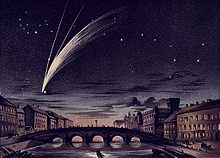- Comet Donati
-
- There are three Donati comets: C/1855 L1 (a.k.a. 1855 II), C/1858 L1 (this one), and C/1864 R1 (a.k.a. 1864 I).
C/1858 L1 (Donati) Discovery Discovered by: Giovanni Battista Donati Discovery date: 1858 Alternate designations: 1858 VI Orbital characteristics A Epoch: 1858-Oct-08
(JD 2399960.5)Aphelion distance: ~289 AU[1] Perihelion distance: 0.578 AU[2] Semi-major axis: ~147 AU[1] Eccentricity: 0.996 Orbital period: ~1,739 yr[1] Inclination: 116.9°[2] Last perihelion: September 30, 1858[2] Next perihelion: unknown Comet Donati, or Donati's Comet, formally designated C/1858 L1 and 1858 VI, is a long-period comet named after the Italian astronomer Giovanni Battista Donati who first observed it on June 2, 1858. After the Great Comet of 1811, it was the most brilliant comet that appeared in the 19th century. It was also the first comet to be photographed. It was nearest the Earth on October 10, 1858. The comet has an orbital inclination of 116.9°.[2]
Abraham Lincoln, then a candidate for a seat in the U.S. Senate, sat up on the porch of his hotel in Jonesboro, Illinois to see "Donti's Comet" on September 14, 1858, the night before the third of his historic debates with Stephen Douglas.[3] Donati's Comet appears as a streak and star in the early evening sky of a painting by William Dyce, A Recollection of October 5th, 1858.[4]
See also
- C/1857 V1 (a.k.a. 1857 VI), Comet Donati-van Arsdale
- C/1864 O1 (a.k.a. 1864 III), Comet Donati-Toussaint
References
- ^ a b c Horizons output. "Barycentric Osculating Orbital Elements for Comet C/1858 L1 (Donati)". http://ssd.jpl.nasa.gov/horizons.cgi?find_body=1&body_group=sb&sstr=C/1858+L1. Retrieved 2011-02-03. (Solution using the Solar System Barycenter and barycentric coordinates. Select Ephemeris Type:Elements and Center:@0)
- ^ a b c d "JPL Small-Body Database Browser: C/1858 L1 (Donati)". Jet Propulsion Laboratory. 1859-03-04 last obs. http://ssd.jpl.nasa.gov/sbdb.cgi?sstr=C/1858+L1. Retrieved 2011-05-15.
- ^ Page 273, White, Ronald C. Jr., 2009. A. Lincoln: A Biography, first edition. New York: Random House. 796 pages.
- ^ Rothstein, Edward. Darwin's wake splashed artists, too. March 2, 2009. Exhibition review, New York Times, accessed March 4, 2009.
External links
- Orbital simulation from JPL (Java) / Horizons Ephemeris
Categories:- Comet stubs
- Comets
- 1858 in science
Wikimedia Foundation. 2010.

